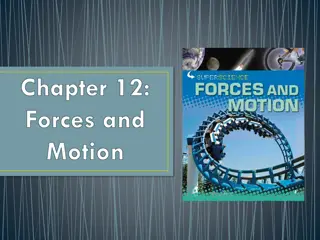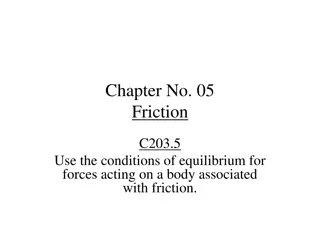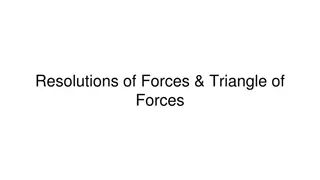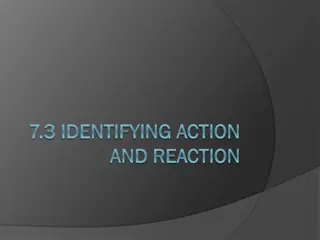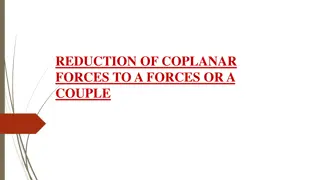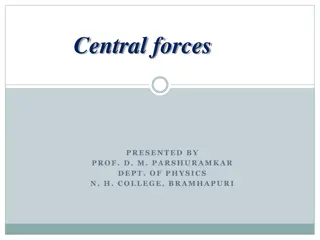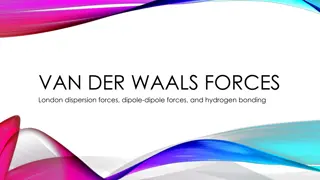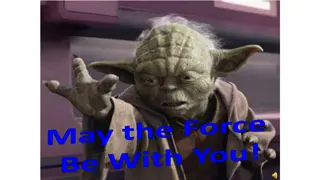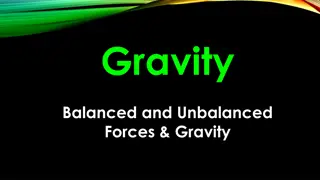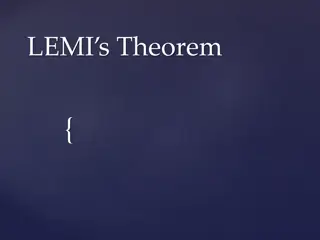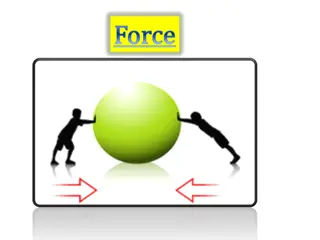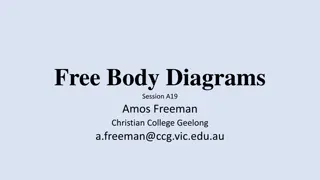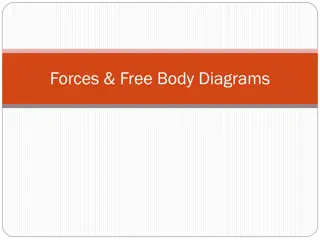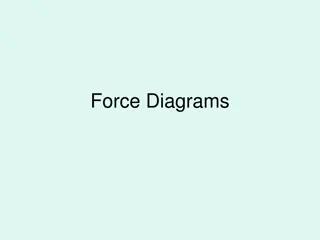Physics Forces Problems in Education Curriculum
Explore forces problems in physics education with examples of tug-of-war scenarios and explanations on friction forces. This content delves into the application of physics principles in practical scenarios to aid understanding in science and mathematics education research. Discover how to handle forces and interactions in physics problems effectively.
Download Presentation

Please find below an Image/Link to download the presentation.
The content on the website is provided AS IS for your information and personal use only. It may not be sold, licensed, or shared on other websites without obtaining consent from the author.If you encounter any issues during the download, it is possible that the publisher has removed the file from their server.
You are allowed to download the files provided on this website for personal or commercial use, subject to the condition that they are used lawfully. All files are the property of their respective owners.
The content on the website is provided AS IS for your information and personal use only. It may not be sold, licensed, or shared on other websites without obtaining consent from the author.
E N D
Presentation Transcript
FACULTY OF EDUCATION FACULTY OF EDUCATION F A C U L T Y O F E D U C A T I O N Department of Curriculum and Pedagogy Physics Forces Problems Science and Mathematics Education Research Group Supported by UBC Teaching and Learning Enhancement Fund 2012-2015
Question Title Question Title Forces Problems Retrieved from: http://www.technologytom.com/html/forces_in_bridges.html
Question Title Question Title Forces Problems The following questions have been compiled from a collection of questions submitted on PeerWise (https://peerwise.cs.auckland.ac.nz/) by teacher candidates as part of the EDCP 357 physics methods courses at UBC.
Question Title Question Title Forces Problems I Bob and Yoshiko are having a tug-of-war on the wooden floor in the gymnasium. Bob has a mass of 78.5 kg and Yoshiko weighs 980 N. If Bob pulls with a force of 75N and is winning the tug-of-war (pulling Yoshiko towards him), what force FY is Yoshiko pulling with on the rope? Assume the acceleration due to gravity is 9.81 m/s2. A. FY = 55 N B. FY = 70 N C. FY = 75 N D. FY = 80 N
Question Title Question Title Solution Answer: C Justification: No matter who is winning the tug-of-war, the forces applied on either end of the rope must be equal in magnitude, but opposite in direction or else the rope will break or slip out of one of their hands. Therefore the force applied by Yoshiko on the rope is FY = 75 N (Answer C). FB FY Bob Yoshiko
Question Title Question Title Solution continued Further Explanation: The person who is "winning the tug-of-war here is the person who has the greatest force of friction working against them. As Bob pulls on the rope he pushes the ground towards Yoshiko and as a result, the force of friction on Bob acts in the direction opposite of Yoshiko. A similar argument can be made for the force of friction on Yoshiko that pulls Bob. However, for Bob to be "winning" the force of friction being applied to him by the ground must be greater than the force of friction being applied to Yoshiko by the ground. Furthermore, this is only possible if the coefficient of static friction for Bob ( B) is larger than the coefficient of static friction for Yoshiko ( Y) because Yoshiko has a larger mass and therefore if both Bob and Yoshiko had the same coefficient of static friction between them and the floor Yoshiko will always win because the force of friction Ff = mg.
Question Title Question Title Forces Problems II Bob and Yoshiko are having a tug-of-war on the wooden floor in the gymnasium. Bob has a mass of 78.5 kg and Yoshiko weighs 980 N. In order for Bob to win he knows that he needs to increase his grip on the wooden floor so he decides to go barefoot while Yoshiko is wearing shoes. If the coefficient of static friction between Yoshiko's shoes and the floor is Y = 0.62, what does the coefficient of static friction between Bob's bare feet and the floor ( B) need to be such that he can win? Choose the best answer. The acceleration due to gravity is 9.81 m/s2. A. B> 0.62 B. B< 0.62 C. B> 0.79 D. 0.62 < B < 0.79 E. B< 0.79
Question Title Question Title Solution Answer: C Justification: To solve this question it is best to draw a free body diagram for Bob and Yoshiko. Since the net force on the rope is zero this means that the forces of friction need to be accounted for. +ve direction FfB = Force of friction on Bob FfY = Force of friction on Yoshiko FNB = Normal force on Bob FNY = Normal force on Yoshiko FgB = Force of gravity on Bob FgY = Force of gravity on Yoshiko FBfloor = Force of Bob on the floor FYfloor = Force of Yoshiko on the floor Bob Yoshiko FNB FNY FfB FBfloor FYfloor FfY FgB FgY
Question Title Question Title Solution continued The force of friction Ff= FN where FN is the normal force defined by FN= mg. We can calculate the magnitude of each of the normal forces for Bob and Yoshiko: FNB = 78.5 9.81 = 770 N FNY = 980 N (given to us as part of the question Yoshiko s weight) Defining the direction Yoshiko is pulling as positive we get: FTotal = FfY FfB FTotal = YFNY BFNB FTotal = 0.62 980 B 770 FTotal = 608 770 B Now we need the total force to be in the direction Bob is pulling (defined as the negative direction here). This means that we need 0 > FTotal.
Question Title Question Title Solution continued 2 Therefore we can say: Answer A( B> 0.62) is incorrect because for 0.62 < B < 0.79 we know that Yoshiko will still win, so this answer does not narrow down the range of B to be considered the best answer. Answer B( B < 0.62) is incorrect because this would still result in Yoshiko winning. Answer D(0.62 < B < 0.79) is incorrect because this would still result in Yoshiko winning. Answer E( B < 0.79) is also incorrect because this would still result in Yoshiko winning. 0 > FTotal = 608 770 B 0 > 608 770 B 770 B> 608 B > 0.79 (Answer C)
Question Title Question Title Forces Problems III You have one car with a mass of 1500 kg driving at 10 km/h, and one cannonball with a mass of 1.5 kg flying at 500 km/h. If both objects are heading directly towards each other, which object will have more force applied to it when they collide? A. The rocket will have more force applied to it. B. The car will have more force applied to it. C. They will both have the same amount of force applied to them.
Question Title Question Title Solution Answer: C Justification: Newton's third law states that for every force there is an equal and opposite force. So the force on one of the objects colliding will be the same as the force on the other one. However, each object will experience a very different result because of the force. The car has a momentum of 1500 kg 10 km/h = 15,000 kg km/h The cannonball has a momentum of 1.5 kg 500 km/h = 750 kg km/h. (The regular units for momentum are kg*m/s, but we are simply doing a numerical comparison so we don't really have to worry about the units as long as both numbers we are providing have the same units.) We can immediately see that there is a very large difference between the momentum of the two objects.
Question Title Question Title Solution continued Even though the car is travelling at only 10 km/h, its momentum is very large because it has a lot of mass. On the other hand, the cannonball, despite travelling very quickly (at 500 km/h) has a relatively low momentum because its mass is quite small. The same force applied to both objects will have a big effect on the momentum of the cannonball, but not as much as the momentum of the car. So when the car and the cannonball collide, the car will most likely keep going while the cannonball will be stopped or destroyed. That is not to say that the car will be undamaged, as it is still going to have a lot of force applied to it so it will likely also be damaged.
Question Title Question Title Forces Problems IV Steve is pushing a pair of blocks across a frictionless surface. Steve is able to push them with a force of 100N. (Assume Steve has spiked shoes to maintain his grip on the frictionless surface). Box A has a mass of 40 kg. Box B has a mass of 60 kg. What force does Box A exert on Box B? A. 100 N B. 60 N C. 40 N D. 0 N
Question Title Question Title Solution Answer: B Justification: Box A exerts a force of 60 N on Box B. We can determine this by thinking about the two boxes as one system accelerating under Steve's pushing force of 100N, what that means for the system's acceleration, and then applying that acceleration to each box. (We can consider Steve to be an external force, not a part of the system.) The total force on the system is 100 N. We know that the total mass of the system is: 40 kg + 60 kg = 100 kg From this, we can determine the acceleration of both boxes. F= ma a = F / m = 100 N / 100 kg = 1 m/s2
Question Title Question Title Solution continued What we need to understand is that just because both boxes are accelerating at 1 m/s2, that does not mean that the net force on the boxes is the same, because they have different masses. Fnet on A = mA a Fnet on A= 40 kg 1 m/s2 Fnet on A= 40 N The only object that can exert a force on Box B is Box A, so the Force that Box A exerts on Box B must be 60 N. (Answer B) Fnet on B = mB a Fnet on B= 60 kg 1 m/s2 Fnet on B= 60 N We also know that if Box A is pushing on B, then Box B must exert an equal, but opposite force on Box A. And so we can see that the net force on Box A = 100 N (Steve pushing) 60 N (Box B) = 40 N.
Question Title Question Title Solution continued 2 We can confirm this by drawing some free body diagrams. Y X
Question Title Question Title Solution continued 3 A is incorrect because it is assuming that the totality of the Force Steve exerts on Box A is transferred to Box B. C is incorrect. You might have arrived at this result because you might have switched the forces exerted by the boxes, or because you assumed that the 40 kg box would exert 40 N of force rather than have a net force of 40 N. D is incorrect because you might have assumed that because the whole system of boxes was moving there was no internal force.
Question Title Question Title Forces Problems V Compare the acceleration and net force of the javelin at T1 and T2. T1 occurs the instant after the javelin leaves the thrower's hand. T2 occurs at the highest point in the javelin's trajectory. A. a1>a2and Fnet1>Fnet2 B. a1=a2and Fnet1=Fnet2 C. a1<a2and Fnet1=Fnet2 D. a1<a2and Fnet1<Fnet2 E. a1=a2and Fnet1>Fnet2
Question Title Question Title Solution Answer: B Justification: The first thing to recall is how acceleration and forces are related: Fnet= m a Since the mass of the javelin does not change from point T1 to T2, we know that whatever relation there is between a1 and a2 (=, < or >), then that same relation must hold for Fnet1 and Fnet2. Therefore we can eliminate options C and E. The key to answering this question correctly is realizing that the thrower exerts no force on the javelin after he releases it. Since at point T1 the javelin has left the thrower s hand, the only force acting on the javelin is the force of gravity, which in the absence of other forces will be equal to the net force. The same is true for point T2.
Question Title Question Title Solution continued Since the net force is the same throughout the flight, the acceleration will also be the same. Since T1 and T2 are both times during the flight of the javelin, a1=a2 and Fnet1= Fnet2 (Answer B). A is incorrect because it implies that the thrower is still exerting a force on the javelin after he has released it. C is incorrect because it suggests that the javelin's mass has changed during its flight. D is incorrect because it implies that the thrower is exerting a force on the javelin after he has released it. E is incorrect because it implies that the mass of the spear changes during its flight.
Question Title Question Title Forces Problems VI A lever has two boxes on the same side, a 15 kg box which is 0.5 m from the fulcrum, and a 10 kg box which is 0.75 m from the fulcrum. A visual representation of the setup. Note that in this image, props are keeping the lever balanced.
Forces Problems VI Question Title Question Title continued If you only have one 10 kg box, how far from the fulcrum on the other side of the lever do you need to place it to have the lever balanced? A. 1.75 m B. 1.5 m C. 1.25 m D. 1 m
Question Title Question Title Solution Answer: B Justification: To find the distance needed to place our 10kg box, we need to determine the torque (also called the moment of force) on the lever from the other two boxes. To do this, we need to add the individual torque from both boxes together. To find the torque exerted by a mass on a lever, we need to multiply the force that the object exerts on the lever by the distance from the fulcrum. The only force that the boxes exert are due to gravity, therefore we need to multiply the mass of the boxes by the acceleration caused by Earth s gravity (which we have approximated to be 10 m/s2). So the total torque of both boxes will be: = (m15kgbox g distance15kgbox) + (m10kgbox g distance10kgbox) = (15kg 10m/s2 0.5m ) + (10kg 10m/s2 0.75m)
Question Title Question Title Solution continued = 75 kg.m/s2.m + 75 kg.m/s2.m = 150 N.m (Here we have simplified the units, as 1kg.m/s2 is equal to 1N.) Now, we can calculate the distance needed for a 10kg mass to exert 150 N.m of torque: = mass g distance 150 N.m = 10 kg 10 m/s2 d d = 150 N.m / 100 N d = 1.5 m (Answer B) This answer should be more readily apparent if we realize that a 15 kg mass at 0.5 m and a 10 kg mass at 0.75 m exert the same torque (75 N.m). Their total torque is equivalent to two 10 kg masses at 0.75 m, so in order to balance them with one mass of 10 kg, it would have to be at twice the distance (0.75 2 = 1.5 m).









